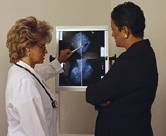
MONDAY, Nov. 21 (HealthDay News) — The Canadian Task Force on Preventive Health Care on Monday issued new recommendations on breast cancer screening, and they’re similar to controversial guidelines issued in 2009 by a U.S. governmental panel.
As the U.S. Preventive Services Task Force (USPSTF) recommended two years ago, the government-appointed Canadian panel of experts is also suggesting that women aged 40 to 49 who are at average risk for breast cancer not get routine mammograms.
The Canadian task force has also dropped recommendations for breast self-exams and clinical exams for women with no symptoms.
The new guidelines, replacing those issued in 2001, are for women at average risk of breast cancer only. The new guidelines also recommend longer mammogram screening intervals for women aged 50 to 74 — to once every two or three years. Previous guidelines had recommended mammograms once every two years for women aged 50 to 69 and did not address women aged 70 to 74.
The earlier guidelines had said women between 40 and 49 could be screened, but they were not to be actively recruited for screening, noted Patrice Lindsay, an expert in “best practices” for medical care and an appointed member of the Canadian task force.
According to Lindsay, “there has been a considerable amount of evidence out over the past few years looking at the benefits and harms of screening practices. The evidence really doesn’t support more frequent screening in terms of having an impact on the outcome.” The outcomes considered, she said, are a diagnosis of breast cancer and breast cancer death.
The guidelines are published Nov. 21 in the Canadian Medical Association Journal.
The new guidelines may rekindle the debate on mammography among experts in the United States.
“I believe the U.S. and Canada recommendations have much in common,” said Dr. Michael LeFevre, co-vice chair of the USPSTF and vice chair of family and community medicine at the University of Missouri, in Columbia.
In 2009, the USPSTF recommended every-other-year mammograms for women aged 50 to 74. They advised women under 50 to discuss the test with their doctor and only then decide whether to get a mammogram, based on patient preference and other factors. They also recommended against teaching breast self-exam. The USPSTF said evidence was insufficient to assess the benefits and harms of doing clinical breast exams in women aged 40 and older.
LeFevre believes that both panels’ recommendations hinge on a balancing of risks and benefits to women. Benefits include finding tumors early; harms include the risk for a false-positive test and then unnecessary worry and over-treatment.
“Both Canada and the U.S. recommendations recommend regular screenings for women 50 to 74, although the U.S. task force recommends every two years and theirs [Canada’s] provides the option of every two or three,” LeFevre said.
“The [U.S.] task force assessment for those 40 to 49 was that the benefits do outweigh the harms but only by a small amount, and the decision must be weighed individually,” LeFevre said.
Not everyone agrees with the USPSTF on that assessment, however. The American Cancer Society, for example, continues to recommend annual mammograms beginning at age 40.
In a commentary that accompanies the Canadian guidelines, Dr. Peter Gotzsche of Copenhagen contends that, “The best method we have to reduce the risk of breast cancer is to stop the screening programs.” He focused on the problem of “overdiagnosis,” defined as treating a cancer that would never have caused problems in a patient’s lifetime. Gotzsche contends that the level of this type of overdiagnosis in countries with organized screening programs is now about 50 percent.
Other experts took a different view of the Canadian guidelines.
“These are ridiculous recommendations,” said Dr. Stamatia Destounis, a radiologist in Rochester, N.Y., and a managing partner at Elizabeth Wende Breast Care.
Among her criticisms, she said, is that doctors simply cannot predict which of the women would have had a cancer that remained harmless during her lifetime. As for not screening women aged 40 to 49, she said, “They are the moms, the worker bees, the women who have several decades left of working, and we want to find these things [tumors] as small as possible.”
Still, the experts did agree on one piece of advice for women: All women should discuss screening with their doctor to decide what is best for them.
LeFevre said that when he talks to other U.S. doctors about mammography screening, he tells them: “At age 40, discuss. At age 50, recommend or encourage. At age 60, strongly encourage.”
More information
To learn more about the U.S. panel’s recommendations, head to the U.S. Preventive Services Task Force.

